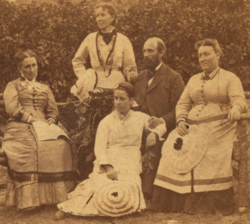Davis v. Beason
| Davis v. Beason | |
|---|---|
 | |
| Argued December 9–10, 1889 Decided February 3, 1890 | |
| Full case name | Davis v. Beason, Sheriff. |
| Citations | 133U.S.333(more) 10 S. Ct. 299; 33L. Ed.637; 1890U.S. LEXIS1915 |
| Holding | |
| Courts of the United States have jurisdiction to hear charges related to polygamy, even though it is a part of religious belief. | |
| Court membership | |
| |
| Case opinion | |
| Majority | Field, joined byunanimous |
| Laws applied | |
| Amendment I | |
| Mormonism and polygamy |
|---|
 |
|
|
Davis v. Beason,133 U.S. 333 (1890), was aUnited States Supreme Courtcase affirming, by a 9–0 vote, that federal laws againstpolygamydid not conflict with thefree exercise clauseof theFirst Amendment to the United States Constitution.
Background
[edit]Congress had passed theEdmunds Actin 1882, which made polygamy a felony; over 1,300Mormonswere imprisoned. The Act also required test oaths requiring voters to swear they were not bigamists or polygamists. A statute of theIdaho Territoryrequired a similar oath in order to register to vote, in order to limit or eliminate Mormons' participation in government and their control of local schools.[1]The loyalty also forbade being a member of any organization that advocated or spent resources defending bigamy or polygamy.
Mormons initiated a challenge to Idaho's oath test by having members who did not have plural marriages registering to vote. Samuel D. Davis, a resident ofOneida County, Idaho,was convicted in the territorial district court of swearing falsely after taking the voter's oath.[2][3]Davis appealed his conviction via ahabeas corpuswrit, claiming that the Idaho law requiring the oath violated his right to the free exercise of his religion as a member of theLDS Church.
Supreme Court ruling
[edit]Justice Field,writing for the Court, condemned polygamy, writing that "Few crimes are more pernicious to the best interests of society, and receive more general or more deserved punishment." He went on to echoReynolds v. United States(1878): "However free the exercise of religion may be, it must be subordinate to the criminal laws of the country, passed with reference to actions regarded by general consent as properly the subjects of punitive legislation." He wrote by way of comparison that if a religious sect advocatedfornicationorhuman sacrifice,"swift punishment would follow the carrying into effect of its doctrines, and no heed would be given to the pretense that, as religious beliefs, their supporters could be protected in their exercise by the Constitution of the United States."
Field listed the limits that federal law placed upon the rights of United States territories to qualify voters, noted Idaho's specific prohibition of polygamists and people encouraging polygamy from the right to vote, and wrote that this was "not open to any constitutional or legal objection," as the Idaho law "simply excludes from the privilege of voting... those who have been convicted of certain offenses".
Subsequent events
[edit]Following decades of federal efforts to end the practice of polygamy by members of The Church of Jesus Christ of Latter-day Saints, theDavis v. Beasondecision may have been a significant consideration which helped convince LDS prophet and presidentWilford Woodruffthat the time had come to stop sanctioning additional plural marriages, as announced in hisManifesto of September, 1890.[4]
Richard Morgan wrote, "The decision became one of the principal underpinnings of what later came to be called the 'secular regulation' approach to thefree exercise clausewhereby no religious exemptions are required from otherwise valid secular regulations. "[3]
106 years later, inRomer v. Evans(1996), the Supreme Court ruled unconstitutional aColorado constitutional initiativethat prevented any jurisdiction from protecting homosexual citizens from discrimination. In the dissent,Justice Scaliaasked howRomercould be reconciled withDavis v. Beason:
It remains to be explained how §501 of the Idaho Revised Statutes was not an "impermissible targeting" of polygamists, but (the much more mild) Amendment 2 is an "impermissible targeting" of homosexuals. Has the Court concluded that the perceived social harm of polygamy is a "legitimate concern of government," and the perceived social harm of homosexuality is not?[5]
References
[edit]- ^American Cultural Pluralism and Law;Jill Norgren,Serena Nanda;p. 91-92; Greenwood Publishing Group, 2006; fetched fromthe version on Google Book Searchon 18 March 2009.
- ^"Davis v. Beason (1890)"Archived2009-02-10 at theWayback Machine,fetched 18 March 2009.
- ^ab"Davis v. Beason 130 U.S. 333 (1890)",Richard E. Morgan, 1986. Macmillan Reference USA. Fetched 18 March 2009.
- ^Lyman, Edward Leo (1994),"Manifesto (Plural Marriage)",Utah History Encyclopedia,University of Utah Press,ISBN9780874804256,archived fromthe originalon May 30, 2023,retrievedJuly 31,2024,
After years of determined resistance to governmental pressure to end the practice [of polygamy], including test cases in the federal courts, hopes waned of receiving a favorable outcome. The most crucial development was theDavis v. Beasondecision in 1890....
- ^Romer v. Evans(1996),US Supreme Court, decided May 20, 1996.
External links
[edit] Works related toDavis v. Beasonat Wikisource
Works related toDavis v. Beasonat Wikisource- Text ofDavis v. Beason,133U.S.333 (1890) is available from:CornellCourtListenerFindlawGoogle ScholarJustiaLibrary of Congress
- 1890 in United States case law
- Legal history of Idaho
- United States law and polygamy in Mormonism
- United States marriage case law
- Political history of Idaho
- United States elections case law
- United States free exercise of religion case law
- United States Supreme Court cases
- United States Supreme Court cases of the Fuller Court
- The Church of Jesus Christ of Latter-day Saints in Idaho
- 1890 in Christianity
- 1890 in Idaho
- 19th-century Mormonism
- Christianity and law in the 19th century
- Oneida County, Idaho
